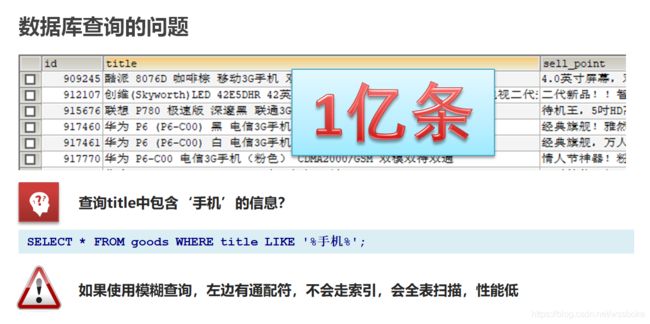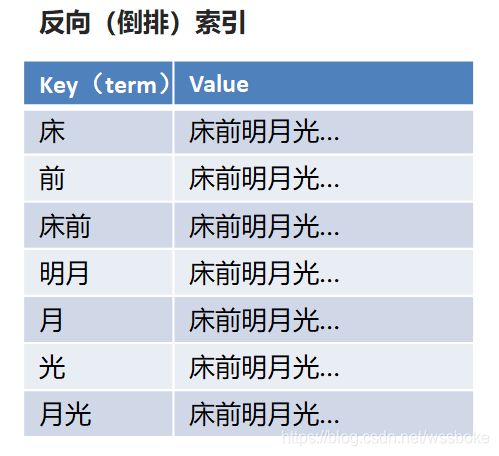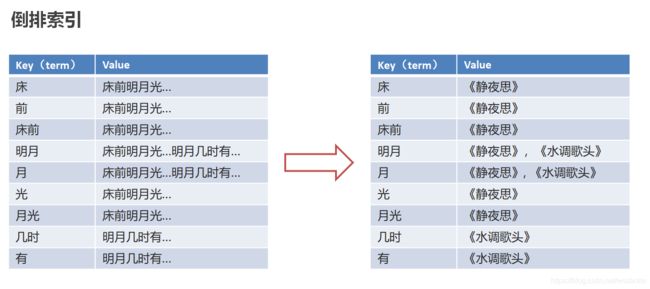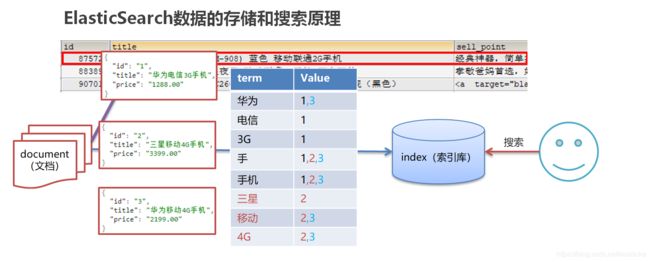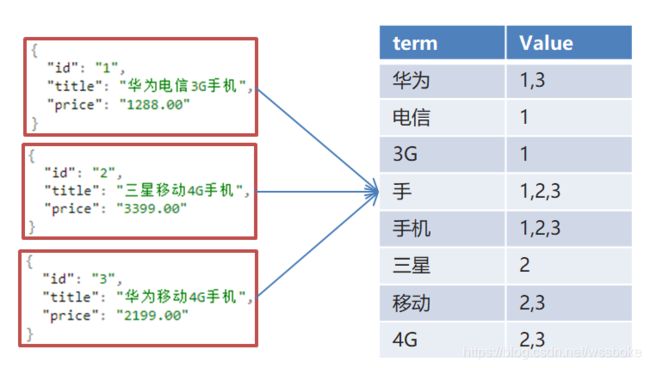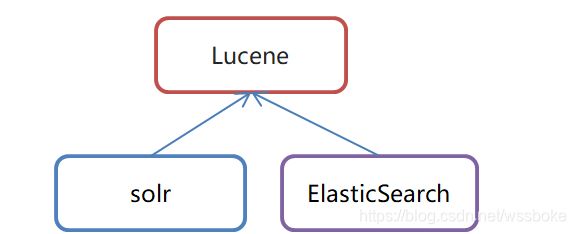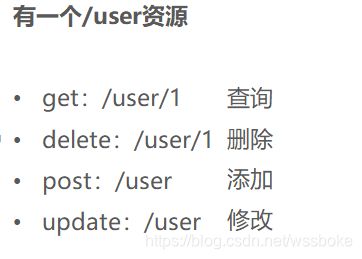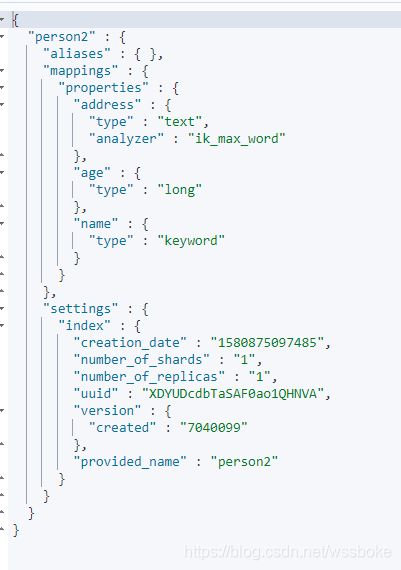ElasticSearch初识
1.1-ElasticSearch初识
ES是作为搜索使用的
2.1-基于数据库查询的问题
2.2-倒排索引
倒排索引:将文档进行分词,形成词条和id的对应关系即为反向索引。
以唐诗为例,所处包含“前”的诗句
正向索引:由《静夜思》–>窗前明月光—>“前”字
反向索引:“前”字–>窗前明月光–>《静夜思》
“床前明月光”–> 分词
将一段文本按照一定的规则,拆分为不同的词条(term)
倒排索引:将各个文档中的内容,进行分词,形成词条。然后记录词条和数据的唯一标识(id)的对
应关系,形成的产物
2.3-ES存储和查询的原理
index(索引):相当于mysql的库
document(文档):相当于mysql的表中的数据(json格式)
数据库查询存在的问题:
- 性能低:使用模糊查询,左边有通配符,不会走索引,会全表扫描,性能低
- 功能弱:如果以”华为手机“作为条件,查询不出来数据
Es使用倒排索引,对title 进行分词
-
使用“手机”作为关键字查询
生成的倒排索引中,词条会排序,形成一颗树形结构,提升词条的查询速度
-
使用“华为手机”作为关键字查询
华为:1,3
手机:1,2,3
2.4-ES概念详解
•ElasticSearch是一个基于Lucene的搜索服务器
•是一个分布式、高扩展、高实时的搜索与数据分析引擎
•基于RESTful web接口
•Elasticsearch是用Java语言开发的,并作为Apache许可条款下的开放源码发布,是一种流行的企业级搜索引擎
•官网:https://www.elastic.co/
应用场景
•搜索:海量数据的查询
•日志数据分析
•实时数据分析
3-安装ElasticSearch
3.1-ES安装
参见ElasticSearch-ES安装.md
查看elastic是否启动
ps -ef|grep elastic
3.2-ES辅助工具安装
参见ElasticSearch-ES安装.md
后台启动
nohup ../bin/kibana &
4-ElasticSearch核心概念
索引(index)
ElasticSearch存储数据的地方,可以理解成关系型数据库中的数据库概念。
映射(mapping)
mapping定义了每个字段的类型、字段所使用的分词器等。相当于关系型数据库中的表结构。
文档(document)
Elasticsearch中的最小数据单元,常以json格式显示。一个document相当于关系型数据库中的一行数据。
倒排索引
一个倒排索引由文档中所有不重复词的列表构成,对于其中每个词,对应一个包含它的文档id列表。
类型(type)
一种type就像一类表。如用户表、角色表等。在Elasticsearch7.X默认type为_doc
\- ES 5.x中一个index可以有多种type。
\- ES 6.x中一个index只能有一种type。
\- ES 7.x以后,将逐步移除type这个概念,现在的操作已经不再使用,默认_doc
5-脚本操作ES
5.1-RESTful风格介绍
RESTful(Representational State Transfer),表述性状态转移,是一组架构约束条件和原则。满足这些约束条件和原则的应用程序或设计就是RESTful。就是一种定义接口的规范。
- 基于HTTP。
- 使用XML格式定义或JSON格式定义。
- 每一个URI代表1种资源。
- 客户端使用GET、POST、PUT、DELETE 4个表示操作方式的动词对服务端资源进行操作:
- GET:用来获取资源
- POST:用来新建资源(也可以用于更新资源)
- PUT:用来更新资源
- DELETE:用来删除资源
5.2-操作索引
添加索引
PUT http://ip:端口/索引名称
查询索引
GET http://ip:端口/索引名称 # 查询单个索引信息
GET http://ip:端口/索引名称1,索引名称2 # 查询多个索引信息
GET http://ip:端口/_all # 查询所有索引信息
•删除索引
DELETE http://ip:端口/索引名称
•关闭、打开索引
POST http://ip:端口/索引名称/_close
POST http://ip:端口/索引名称/_open
5.3-ES数据类型
- 简单数据类型
- 字符串
聚合:相当于mysql 中的运算
text:会分词,不支持聚合
keyword:不会分词,将全部内容作为一个词条,支持聚合
- 数值
- 布尔:boolean
- 二进制:binary
- 范围类型
integer_range, float_range, long_range, double_range, date_range
- 日期:date
- 复杂数据类型
•数组
•对象
[外链图片转存失败,源站可能有防盗链机制,建议将图片保存下来直接上传(img-Y2x1Im27-1594791582195)(C:\Users\gao\AppData\Roaming\Typora\typora-user-images\1592462191509.png)]
5.4-操作映射
PUT person
GET person
#添加映射
PUT person/_mapping
{
"properties":{
"name":{
"type":"text"
},
"age":{
"type":"integer"
}
}
}
#创建索引并添加映射
#创建索引并添加映射
PUT /person1
{
"mappings": {
"properties": {
"name": {
"type": "text"
},
"age": {
"type": "integer"
}
}
}
}
GET person1/_mapping
添加字段
#添加字段
PUT /person1/_mapping
{
"properties": {
"name": {
"type": "text"
},
"age": {
"type": "integer"
}
}
}
5.5-操作文档
•添加文档,指定id
POST /person1/_doc/2
{
"name":"张三",
"age":18,
"address":"北京"
}
GET /person1/_doc/1
•添加文档,不指定id
#添加文档,不指定id, 会随机生成一个id
POST /person1/_doc
{
"name":"张三",
"age":18,
"address":"北京"
}
#查询所有文档
GET /person1/_search
修改文档
PUT person1/_doc/1
{
"name": "万手哥",
"age": 18,
"address": "西湖"
}
删除指定id文档
#删除指定id文档
DELETE /person1/_doc/1
6-分词器
6.1 分词器-介绍
- 分词器(Analyzer):将一段文本,按照一定逻辑,分析成多个词语的一种工具
如:华为手机 — > 华为、手、手机
ElasticSearch 内置分词器
• Standard Analyzer - 默认分词器,按词切分,小写处理
• Simple Analyzer - 按照非字母切分(符号被过滤), 小写处理
• Stop Analyzer - 小写处理,停用词过滤(the,a,is)
• Whitespace Analyzer - 按照空格切分,不转小写
• Keyword Analyzer - 不分词,直接将输入当作输出
• Patter Analyzer - 正则表达式,默认\W+(非字符分割)
• Language - 提供了30多种常见语言的分词器
ElasticSearch 内置分词器对中文很不友好,处理方式为:一个字一个词, 我们可以安装中文分词器
6.2 分词器-介绍
•IKAnalyzer是一个开源的,基于java语言开发的轻量级的中文分词工具包
•是一个基于Maven构建的项目
•具有60万字/秒的高速处理能力
•支持用户词典扩展定义
•下载地址:https://github.com/medcl/elasticsearch-analysis-ik/archive/v7.4.0.zip
安装包在资料文件夹中提供
6.3-ik分词器安装
参见 ik分词器安装.md
执行如下命令时如果出现 打包失败(501码)将maven镜像换成阿里云的
mvn package
/opt/apache-maven-3.1.1/conf/setting.xml
<mirror>
<id>alimavenid>
<name>aliyun mavenname>
<url>http://maven.aliyun.com/nexus/content/groups/public/url>
<mirrorOf>centralmirrorOf>
mirror>
6.4-ik分词器使用
IK分词器有两种分词模式:ik_max_word和ik_smart模式。
1、ik_max_word
会将文本做最细粒度的拆分,比如会将“乒乓球明年总冠军”拆分为“乒乓球、乒乓、球、明年、总冠军、冠军。
#方式一ik_max_word
GET /_analyze
{
"analyzer": "ik_max_word",
"text": "乒乓球明年总冠军"
}
ik_max_word分词器执行如下:
{
"tokens" : [
{
"token" : "乒乓球",
"start_offset" : 0,
"end_offset" : 3,
"type" : "CN_WORD",
"position" : 0
},
{
"token" : "乒乓",
"start_offset" : 0,
"end_offset" : 2,
"type" : "CN_WORD",
"position" : 1
},
{
"token" : "球",
"start_offset" : 2,
"end_offset" : 3,
"type" : "CN_CHAR",
"position" : 2
},
{
"token" : "明年",
"start_offset" : 3,
"end_offset" : 5,
"type" : "CN_WORD",
"position" : 3
},
{
"token" : "总冠军",
"start_offset" : 5,
"end_offset" : 8,
"type" : "CN_WORD",
"position" : 4
},
{
"token" : "冠军",
"start_offset" : 6,
"end_offset" : 8,
"type" : "CN_WORD",
"position" : 5
}
]
}
2、ik_smart
会做最粗粒度的拆分,比如会将“乒乓球明年总冠军”拆分为乒乓球、明年、总冠军。
#方式二ik_smart
GET /_analyze
{
"analyzer": "ik_smart",
"text": "乒乓球明年总冠军"
}
ik_smart分词器执行如下:
{
"tokens" : [
{
"token" : "乒乓球",
"start_offset" : 0,
"end_offset" : 3,
"type" : "CN_WORD",
"position" : 0
},
{
"token" : "明年",
"start_offset" : 3,
"end_offset" : 5,
"type" : "CN_WORD",
"position" : 1
},
{
"token" : "总冠军",
"start_offset" : 5,
"end_offset" : 8,
"type" : "CN_WORD",
"position" : 2
}
]
}
由此可见 使用ik_smart可以将文本"text": "乒乓球明年总冠军"分成了【乒乓球】【明年】【总冠军】
这样看的话,这样的分词效果达到了我们的要求。
6.5 使用IK分词器-查询文档
•词条查询:term
词条查询不会分析查询条件,只有当词条和查询字符串完全匹配时才匹配搜索
•全文查询:match
全文查询会分析查询条件,先将查询条件进行分词,然后查询,求并集
二者区别?
**term是代表完全匹配,即不进行分词器分析,文档中必须包含整个搜索的词汇 . 而match查询的时候,elasticsearch会根据你给定的字段先分词 再查询去并集.
1.创建索引,添加映射,并指定分词器为ik分词器
PUT person2
{
"mappings": {
"properties": {
"name": {
"type": "keyword"
},
"address": {
"type": "text",
"analyzer": "ik_max_word"
}
}
}
}
2.添加文档
POST /person2/_doc/1
{
"name":"张三",
"age":18,
"address":"北京海淀区"
}
POST /person2/_doc/2
{
"name":"李四",
"age":18,
"address":"北京朝阳区"
}
POST /person2/_doc/3
{
"name":"王五",
"age":18,
"address":"北京昌平区"
}
3.查询映射
GET person2
4.查看分词效果
GET _analyze
{
"analyzer": "ik_max_word",
"text": "北京海淀"
}
5.词条查询:term
查询person2中匹配到"北京"两字的词条
GET /person2/_search
{
"query": {
"term": {
"address": {
"value": "北京天安门"
}
}
}
}
6.全文查询:match
全文查询会分析查询条件,先将查询条件进行分词,然后查询,求并集
GET /person2/_search
{
"query": {
"match": {
"address":"北京昌平"
}
}
}
7-ElasticSearch JavaApi-
7.1SpringBoot整合ES
①搭建SpringBoot工程
②引入ElasticSearch相关坐标
<dependency>
<groupId>org.elasticsearch.clientgroupId>
<artifactId>elasticsearch-rest-high-level-clientartifactId>
<version>7.4.0version>
dependency>
<dependency>
<groupId>org.elasticsearch.clientgroupId>
<artifactId>elasticsearch-rest-clientartifactId>
<version>7.4.0version>
dependency>
<dependency>
<groupId>org.elasticsearchgroupId>
<artifactId>elasticsearchartifactId>
<version>7.4.0version>
dependency>
③测试
ElasticSearchConfig
@Configuration
@ConfigurationProperties(prefix="elasticsearch")
public class ElasticSearchConfig {
private String host;
private int port;
public String getHost() {
return host;
}
public void setHost(String host) {
this.host = host;
}
public int getPort() {
return port;
}
public void setPort(int port) {
this.port = port;
}
@Bean
public RestHighLevelClient client(){
return new RestHighLevelClient(RestClient.builder(
new HttpHost(host,port,"http")
));
}
}
ElasticsearchDay01ApplicationTests
注意:使用@Autowired注入RestHighLevelClient 如果报红线,则是因为配置类所在的包和测试类所在的包,包名不一致造成的
@SpringBootTest
class ElasticsearchDay01ApplicationTests {
@Autowired
RestHighLevelClient client;
/**
* 测试
*/
@Test
void contextLoads() {
System.out.println(client);
}
}
7.2-创建索引
1.添加索引
/**
* 添加索引
* @throws IOException
*/
@Test
public void addIndex() throws IOException {
//1.使用client获取操作索引对象
IndicesClient indices = client.indices();
//2.具体操作获取返回值
//2.1 设置索引名称
CreateIndexRequest createIndexRequest=new CreateIndexRequest("itheima");
CreateIndexResponse createIndexResponse = indices.create(createIndexRequest, RequestOptions.DEFAULT);
//3.根据返回值判断结果
System.out.println(createIndexResponse.isAcknowledged());
}
2.添加索引,并添加映射
/**
* 添加索引,并添加映射
*/
@Test
public void addIndexAndMapping() throws IOException {
//1.使用client获取操作索引对象
IndicesClient indices = client.indices();
//2.具体操作获取返回值
//2.具体操作,获取返回值
CreateIndexRequest createIndexRequest = new CreateIndexRequest("itcast");
//2.1 设置mappings
String mapping = "{\n" +
" \"properties\" : {\n" +
" \"address\" : {\n" +
" \"type\" : \"text\",\n" +
" \"analyzer\" : \"ik_max_word\"\n" +
" },\n" +
" \"age\" : {\n" +
" \"type\" : \"long\"\n" +
" },\n" +
" \"name\" : {\n" +
" \"type\" : \"keyword\"\n" +
" }\n" +
" }\n" +
" }";
createIndexRequest.mapping(mapping,XContentType.JSON);
CreateIndexResponse createIndexResponse = indices.create(createIndexRequest, RequestOptions.DEFAULT);
//3.根据返回值判断结果
System.out.println(createIndexResponse.isAcknowledged());
}
7.3-查询、删除、判断索引
查询索引
/**
* 查询索引
*/
@Test
public void queryIndex() throws IOException {
IndicesClient indices = client.indices();
GetIndexRequest getRequest=new GetIndexRequest("hehe");
GetIndexResponse response = indices.get(getRequest, RequestOptions.DEFAULT);
Map<String, MappingMetaData> mappings = response.getMappings();
//iter 提示foreach
for (String key : mappings.keySet()) {
System.out.println(key+"==="+mappings.get(key).getSourceAsMap());
}
}
删除索引
/**
* 删除索引
*/
@Test
public void deleteIndex() throws IOException {
IndicesClient indices = client.indices();
DeleteIndexRequest deleteRequest=new DeleteIndexRequest("heihei");
AcknowledgedResponse delete = indices.delete(deleteRequest, RequestOptions.DEFAULT);
System.out.println(delete.isAcknowledged());
}
索引是否存在
/**
* 索引是否存在
*/
@Test
public void existIndex() throws IOException {
IndicesClient indices = client.indices();
GetIndexRequest getIndexRequest=new GetIndexRequest("heihei");
boolean exists = indices.exists(getIndexRequest, RequestOptions.DEFAULT);
System.out.println(exists);
}
7.4-添加文档
1.添加文档,使用map作为数据
@Test
public void addDoc1() throws IOException {
Map<String, Object> map=new HashMap<>();
map.put("name","张三");
map.put("age","18");
map.put("address","北京二环");
IndexRequest request=new IndexRequest("itcast").id("1").source(map);
IndexResponse response = client.index(request, RequestOptions.DEFAULT);
System.out.println(response.getId());
}
2.添加文档,使用对象作为数据
@Test
public void addDoc2() throws IOException {
Person person=new Person();
person.setId("2");
person.setName("李四");
person.setAge(20);
person.setAddress("北京三环");
String data = JSON.toJSONString(person);
IndexRequest request=new IndexRequest("itcast").id(person.getId()).source(data,XContentType.JSON);
IndexResponse response = client.index(request, RequestOptions.DEFAULT);
System.out.println(response.getId());
}
7.5-修改、查询、删除文档
1.修改文档:添加文档时,如果id存在则修改,id不存在则添加
/**
* 修改文档:添加文档时,如果id存在则修改,id不存在则添加
*/
@Test
public void UpdateDoc() throws IOException {
Person person=new Person();
person.setId("2");
person.setName("李四");
person.setAge(20);
person.setAddress("北京三环车王");
String data = JSON.toJSONString(person);
IndexRequest request=new IndexRequest("itcast").id(person.getId()).source(data,XContentType.JSON);
IndexResponse response = client.index(request, RequestOptions.DEFAULT);
System.out.println(response.getId());
}
2.根据id查询文档
/**
* 根据id查询文档
*/
@Test
public void getDoc() throws IOException {
//设置查询的索引、文档
GetRequest indexRequest=new GetRequest("heihei","2");
GetResponse response = client.get(indexRequest, RequestOptions.DEFAULT);
System.out.println(response.getSourceAsString());
}
3.根据id删除文档
/**
* 根据id删除文档
*/
@Test
public void delDoc() throws IOException {
//设置要删除的索引、文档
DeleteRequest deleteRequest=new DeleteRequest("hehe","1");
DeleteResponse response = client.delete(deleteRequest, RequestOptions.DEFAULT);
System.out.println(response.getId());
}
